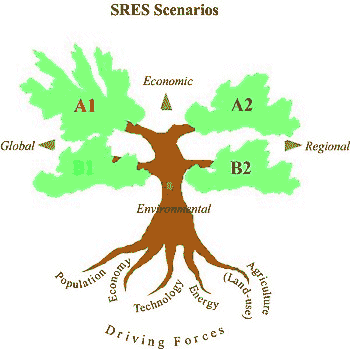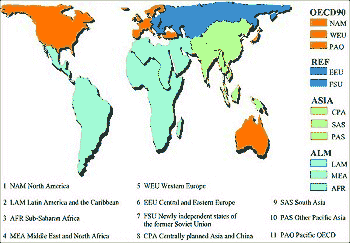4.1. Introduction
In Chapter 4 the main characteristics of the scenarios developed for the Special
Report on Emissions Scenarios (SRES scenarios) are presented. These scenarios
cover a wide range of driving forces from demographic to social and economic
developments, and they encompass a wide range of future greenhouse gas (GHG)
emissions (see Chapter 5). Chapters 2
and 3 provide an overview and assessment of the scenario
literature, the main driving forces of future GHG emissions, and their relationships.
How the driving forces are combined to produce a set of scenarios that cover
the ranges of GHG emissions from the literature is described in this chapter.
Chapters 2 and 3 demonstrate the
large uncertainty in the literature that surrounds both future emissions and
the possible developments of their underlying driving forces. The uncertainties
range from inadequate scientific understanding of the problems, through data
gaps or lack of data, to the inherent uncertainties of future events in general.
Hence alternative scenarios are used to describe the range of possible future
emissions.
The SRES approach involved the development of a set of four alternative scenario
"families" (see Chapter 1, Section 1.7.2). Each family
of SRES scenarios includes a descriptive part (called a "storyline") and a number
of alternative interpretations and quantifications of each storyline developed
by six different modeling approaches (see also Box 1-1
on terminology). Each storyline describes a demographic, social, economic, technological,
and policy future for each of the scenario families. Within each family different
scenarios explore variations of global and regional developments and their implications
for GHG, ozone precursors, and sulfur emissions. Each of these scenarios is
consistent with the broad framework specified by the storyline of the scenario
family.
Each storyline is basically a short "history" of a possible future development
expressed as a combination of key scenario characteristics. These descriptions
are stylized and designed to facilitate specification and further interpretation
of scenario quantifications. The storylines identify particular dynamics, visible
in the world today, that might have important influences on future GHG emissions.
They deliberately explore what might happen if social, economic, technical,
and policy developments take a particular direction at the global level; they
also pay attention to regional differences and interactions, especially between
developing and industrialized countries.

|
| Figure 4-1: The four SRES scenario families
that share common storylines are illustrated as branches of a two-dimensional
tree. The two dimensions indicate the relative orientation of the different
scenario storylines toward economic or environmental concerns and global
and regional scenario development patterns, respectively. There is no
implication that these two are mutually exclusive or incompatible. In
reality, the four scenarios share a space of a much higher dimensionality
given the numerous driving forces and other assumptions needed to define
any given scenario in a particular modeling approach. The A1 storyline
branches out into different groups of scenarios to illustrate that alternative
development paths are possible within one scenario family. |
The broad consensus among the SRES writing team is that the current literature
analysis suggests the future is inherently unpredictable and so views will differ
as to which of the storylines and representative scenarios could be more or
less likely. Therefore, the development of a single "best guess" or "business-as-usual"
scenario is neither desirable nor possible. Nor should the storylines and scenarios
be taken as policy recommendations. The storylines represent the playing out
of certain social, economic, technological, and environmental paradigms, which
will be viewed positively by some people and negatively by others. The SRES
writing team decided on four storylines - an even number helps to avoid the
impression of a "central" or "most likely" case. The team wanted more than two
storylines to help illustrate that the future depends on many different underlying
dynamics; the team wanted no more than four to avoid complicating the process
with too many alternatives. The scenarios cover a wide range of, but not all
possible, futures. In particular, it was decided that possible "surprises" would
not be considered and that there would be no "disaster" scenarios. The team
decided to carry out sensitivity tests within some of the storylines by considering
alternative scenarios with different fossil-fuel reserves, rates of economic
growth, or rates of technical change. These sensitivity analyses resulted in
groups of scenarios within a given scenario family and alternative scenario
interpretations within a scenario group or family (see Section
4.2 below for a description of scenario terminology and taxonomy).
The titles of the storylines are deliberately simple - A1, A2, B1, and B2.
There is no particular order among the storylines (they are listed alphabetically).
Figure 4-1 shows that the SRES scenarios build on the main
driving forces of GHG emissions. Each scenario family is based on a common specification
of the main driving forces.
All four storylines and scenario families describe future worlds that are generally
more affluent compared to the current situation. They range from very rapid
economic growth and technologic change to high levels of environmental protection,
from low-to-high global populations, and from high-to-low GHG emissions. Perhaps
more importantly, all the storylines describe dynamic changes and transitions
in generally different directions. The storylines do not include specific climate-change
policies, but they do include numerous other socio-economic developments and
non-climate environmental policies. As time progresses, the storylines diverge
from each other in many of their characteristic features. In this way they span
the relevant range of GHG emissions and different combinations of their main
sources.
After the basic features and driving forces for each of the four storylines
had been determined, the team quantified the storylines into individual scenarios
with the help of formal (computer) models. While the writing team and the modeling
groups included experts from around the world, all six modeling groups are based
in Europe, North America, and Japan. As indicated above, each model quantification
of a storyline constitutes a scenario, and all scenarios of one storyline constitute
a "scenario family." The six models are representative of different approaches
to emissions-scenario modeling and different integrated assessment frameworks
in the literature, and include so-called top-down and bottom-up models. The
use of different models reflects the SRES Terms of Reference call for methodologic
pluralism and for an open process (see Appendix I).
The number and type of models chosen in the open process was on a voluntary
basis. In January 1997 the Intergovernmental Panel on Climate Change Working
Group II Technical Support Unit (IPCC WGII TSU) sent letters to Governments
asking for nominations of modeling teams to contribute to SRES and advertised
in a number of scientific journals for modelers to participate in SRES. Six
different modeling groups from Europe, North America, and Japan volunteered
to participate in the formulation and development of the scenarios in response
to the call. It is fortunate that they are from three different continents and
also include different methodological approaches used in the literature to develop
quantitative emissions scenarios.
The six models have different regional aggregations. The writing
team decided to group the various global regions into four "macro-regions"
common to all the regional aggregations across the six models (Box
4-1).
|
Box 4-1: Four SRES World Regions
The six modeling
frameworks used to develop the SRES scenarios have different regional
aggregations. The writing team decided to group the various global regions
into four "macro-regions" common to all the different regional aggregations
across the six models (Figure 4.2; see Appendix
IV, Table IV-1). The individual scenarios were formulated with the
respective regional aggregation of each model. Afterward, the input assumptions
and results were summed to correspond to the four macro-regions:
- OECD90 region groups together all member countries of the Organization
for Economic Cooperation and Development as of 1990, the base year of
the participating models, and corresponds to the Annex II countries
originally defined in UNFCCC (1992).
- REF region consists of countries undergoing economic reform
and groups together the East and Central European countries and the
Newly Independent States of the former Soviet Union; it roughly corresponds
to Annex I outside the Annex II countries as defined in UNFCCC (1992).
- ASIA region stands for all developing (non-Annex I) countries
in Asia (excluding the Middle East).
- ALM region stands for the rest of the world and corresponds
to developing (non-Annex I) countries in Africa, Latin America, and
Middle East
In other words, the OECD90 and REF regions together roughly correspond
to Annex I or industrialized (developed) countries (IND), while the ASIA
and ALM regions together roughly correspond to the non-Annex I, or developing
countries (DEV). Developing, or non-Annex I countries (i.e., ASIA and
ALM), are sometimes referred to in the text as the "South" to distinguish
them from the industrialized, or Annex I countries, of the "North" (i.e.,
OECD90 and REF). A detailed description of each region is provided in
Appendix III.
|

|
Figure 4-2: SRES world regions ALM, ASIA, OECD90,
and REF. The developing (DEV) countries, comprising the ALM and ASIA regions,
roughly correspond to non-Annex I countries of the UNFCCC (1992). The industrialized
(IND) countries, comprising the OECD90 and REF regions, roughly correspond
to Annex I countries of the UNFCCC. |
In response to a number of requests from potential user groups
within IPCC and in accordance with a decision of the IPCC Bureau in 1998 to
release draft scenarios to climate modellers for their input in the Third
Assessment Report, the writing team chose one model run to characterize each
scenario family. Scenarios resulting from these runs are called "marker" scenarios
or simply "markers." There are four marker scenarios, each considered characteristic
for one of the four scenario families. The rationale and process for designating
marker scenarios is discussed in more detail in Section
4.4.1.
The SRES scenario quantifications of the main indicators (such
as population and economic growth, characteristics of the energy system, and
the associated GHG emissions) all fall within the range of studies published
in the literature and scenarios documented in the SRES database (see Chapter
2). Quantitative indicators form an important part of each scenario description.
These indicators include gross world product, population, supply and demand
for principal energy forms, energy resource characteristics, the breakdown
of land use, and emissions of various GHGs. The scenarios are designed so
that the evolution of their indicators over the 21 st century falls well within
the range represented by scenarios from the literature and included in the
SRES database (see Chapter 2 and Morita and Lee, 1998;
Nakic´enovic´, et al., 1998). More importantly, they correspond to the qualitative
characteristics of the respective storylines. Also, they were revised iteratively
within the six modeling approaches to achieve internal consistency on the
basis of inputs from the entire SRES writing team and the SRES open process.
Each storyline was characterized initially by two quantitative
"targets," namely global population (15, 10, and 7 billion by 2100 in scenarios
A2, B2, and both A1 and B1, respectively) and global gross domestic product
(GDP) by 2100 (in 1990 US dollars, US$550 trillion for A1, US$250 trillion
for A2, US$350 trillion for B1, and US$250 trillion for B2). These quantitative
targets guided the subsequent quantification of the SRES scenarios with different
model approaches. Generally, the orders of magnitude of these original quantitative
scenario "guideposts" are reflected in the final SRES scenarios (see Table
4-2) and have been adopted in a majority of SRES scenarios. Evidently,
the quantitative characteristics of the four SRES scenario families comprise
many more dimensions than this, in particular regional patterns, differences
in resource and technology availability, land-use changes, non-carbon dioxide
(CO2) GHGs, etc. These are discussed in the subsequent Sections.
|